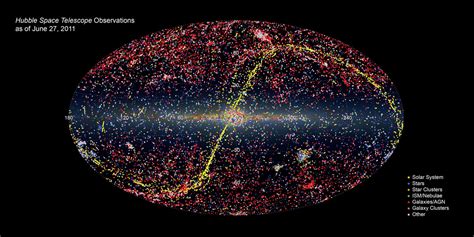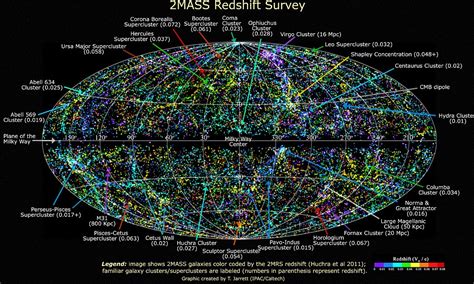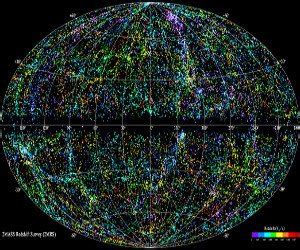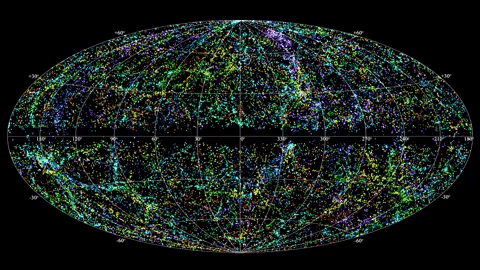Fast Radio Bursts (FRBs) are one of the most enigmatic phenomena in the universe, captivating the attention of astronomers and physicists alike. These fleeting yet powerful bursts of radio waves, originating from far beyond our galaxy, have challenged our understanding of cosmic events. Despite their discovery over a decade ago, the precise origin and nature of FRBs remain a mystery. This article delves into the top 10 discoveries about Fast Radio Bursts, exploring their origins, the role of cutting-edge technology in detecting them, and the profound implications they have on our understanding of the universe.
Explore this topic in-depth with uzocn.com
1. Origin and Nature of Fast Radio Bursts
Fast Radio Bursts (FRBs), intense, short-lived pulses of radio waves lasting mere milliseconds, were first discovered in 2007. This discovery stemmed from the identification of a previously overlooked signal from 2001 within archived data. Despite their brevity, these bursts release an astonishing amount of energy, equivalent to the Sun’s output over an entire day. Adding to the intrigue surrounding FRBs is their enigmatic origin. They appear to emanate from distant regions beyond our Milky Way galaxy, some located billions of light-years away.
The precise origin of Fast Radio Bursts (FRBs) remains an enigma, actively investigated by scientists. Unlike well-understood cosmic events like gamma-ray bursts and supernovae, the mechanism behind FRBs is yet to be established. Numerous theories have been put forward, encompassing highly magnetic neutron stars (magnetars) and even the intriguing possibility of extraterrestrial origin. However, conclusive evidence supporting any specific theory is still lacking.
Studying Fast Radio Bursts (FRBs) presents a significant challenge: their unpredictable nature makes real-time detection difficult. However, thanks to advancements in radio astronomy, over 500 FRBs have been discovered, some repeating and others occurring only once. The investigation of these enigmatic bursts continues to expand our knowledge of high-energy astrophysical processes and the immense scale of the universe.

2. Key Observatories and Telescopes Involved
The groundbreaking discovery and ongoing study of Fast Radio Bursts (FRBs) rely heavily on some of the world’s most advanced radio observatories and telescopes. Among these, the Parkes Radio Telescope in Australia stands out as a key player. This remarkable instrument, nicknamed “The Dish,” boasts a 64-meter diameter and played a pivotal role in detecting the very first FRB in 2001. Since then, it has been instrumental in uncovering a wealth of FRBs, paving the way for deeper scientific understanding of these enigmatic cosmic events.
The Arecibo Observatory in Puerto Rico, a facility of great significance, was instrumental in the discovery of numerous FRBs prior to its tragic collapse in 2020. Its expansive dish enabled the detection of weak signals from distant galaxies, enriching the understanding of these enigmatic bursts with crucial data.
The Canadian Hydrogen Intensity Mapping Experiment (CHIME) has emerged as a key player in the search for Fast Radio Bursts (FRBs). Unlike conventional dish-shaped telescopes, CHIME comprises four massive, fixed cylinders that sweep across the sky daily. Since its activation in 2018, CHIME has significantly expanded the catalogue of known FRBs, including the identification of numerous repeating sources.
These observatories, along with others, have played a vital role in unraveling the mysteries surrounding FRBs. Their observations have significantly narrowed the field of potential sources for these bursts and expanded our understanding of their profound impact on the cosmos.

3. The Role of Artificial Intelligence in Detecting FRBs
The detection of Fast Radio Bursts (FRBs) presents a unique challenge due to their brief and unpredictable nature. This is where artificial intelligence (AI) has become a game-changer. Traditional methods of sifting through vast amounts of data from radio telescopes are time-consuming and often miss the fleeting signals of FRBs. AI, however, can analyze data in real-time, identifying these elusive bursts with remarkable accuracy.
Machine learning algorithms, a subset of AI, have been particularly effective in detecting FRBs. These algorithms are trained on large datasets of known FRB signals, allowing them to recognize patterns and anomalies that might indicate the presence of a new burst. Once trained, these algorithms can process incoming data at a speed and scale far beyond human capability.
One notable success story is the use of AI by the CHIME telescope. AI has enabled CHIME to discover hundreds of new FRBs, including rare repeating bursts, by continuously monitoring and analyzing data streams. This approach has not only increased the number of detected FRBs but also improved our understanding of their characteristics, such as duration and frequency.
AI’s role in FRB detection is a prime example of how technology is revolutionizing astronomy, making it possible to explore and understand the universe in ways previously unimaginable.

4. Notable Theories and Hypotheses
The mysterious nature of Fast Radio Bursts (FRBs) has fueled a plethora of theories and hypotheses about their origin. One prominent theory posits that FRBs are generated by highly magnetized neutron stars, known as magnetars. These stars possess incredibly strong magnetic fields, capable of producing the intense bursts of energy observed in FRBs.
A different hypothesis suggests that FRBs are produced by collisions between neutron stars or black holes. These violent events are recognized for releasing vast quantities of energy, which could potentially explain the short but intense bursts of radio waves observed as FRBs.
Speculation also surrounds the possibility that FRBs are connected to more exotic phenomena, such as cosmic strings or dark matter interactions. These hypotheses suggest that FRBs could offer valuable insights into the fundamental forces and structures that govern the universe.
A more speculative idea proposes that FRBs might be signals from advanced extraterrestrial civilizations. Though less widely accepted, this theory has intrigued some researchers. They suggest that the regularity of certain repeating FRBs could indicate an artificial origin.
The varied theories surrounding FRBs highlight their intricate nature and the mysteries they hold. Ongoing research strives to unlock the secrets behind these captivating cosmic signals.
5. Impact on Understanding Cosmic Events
Fast Radio Bursts (FRBs) have revolutionized our comprehension of cosmic events, propelling the frontiers of contemporary astrophysics. A pivotal contribution of FRB research lies in its potential to illuminate the distribution of matter throughout the cosmos. As FRBs traverse vast cosmic distances, they engage with the intergalactic medium, providing scientists with a means to map the otherwise imperceptible matter dispersed between galaxies.
Furthermore, the energy levels associated with FRBs provide valuable information about intense astrophysical phenomena. For example, if FRBs originate from magnetars, they could shed light on the behavior of these unusual neutron stars, including the evolution of their magnetic fields and their impact on their surroundings. This knowledge could offer broader perspectives on the life cycles of stars and the conditions that lead to their eventual transformation into neutron stars or black holes.
FRBs also offer a unique way to study the early universe. By observing FRBs from distant galaxies, astronomers can gather information about the state of the universe billions of years ago, offering clues about its evolution.
In addition, the discovery of repeating FRBs has opened new avenues for studying the mechanisms behind these bursts, challenging existing theories and encouraging the development of new models to explain such phenomena.
6. Future Research and Exploration Directions
The future of Fast Radio Burst (FRB) research holds the promise of unveiling deeper mysteries surrounding these enigmatic cosmic signals. A key objective is to precisely pinpoint the origins of FRBs. By harnessing advancements in radio astronomy and employing AI-powered detection methods, scientists anticipate significant improvements in localizing FRBs. This enhanced precision will enable them to trace these bursts back to specific galaxies or astrophysical objects, shedding light on their origins.
A promising avenue of research involves studying the environment surrounding FRBs. By analyzing how these bursts interact with the intergalactic medium, researchers can glean more information about the conditions that give rise to them. This could potentially unveil new insights into the structure and composition of the cosmos.
Continued efforts to identify more repeating Fast Radio Bursts (FRBs) are essential. These recurring bursts provide a unique opportunity to study the same source over time, enabling researchers to unravel the mechanisms behind their generation. Such investigations have the potential to unveil entirely new classes of astrophysical phenomena.
Collaborations between international observatories and the development of next-generation telescopes, such as the Square Kilometre Array (SKA), will further enhance our ability to detect and study FRBs, paving the way for breakthroughs that could reshape our understanding of the universe.
Fast Radio Bursts remain one of the most intriguing cosmic mysteries, offering profound insights into the universe’s most extreme phenomena. As technology advances and our understanding deepens, FRBs promise to reveal new secrets about cosmic matter, energy, and the very fabric of space itself.
uzocn.com


